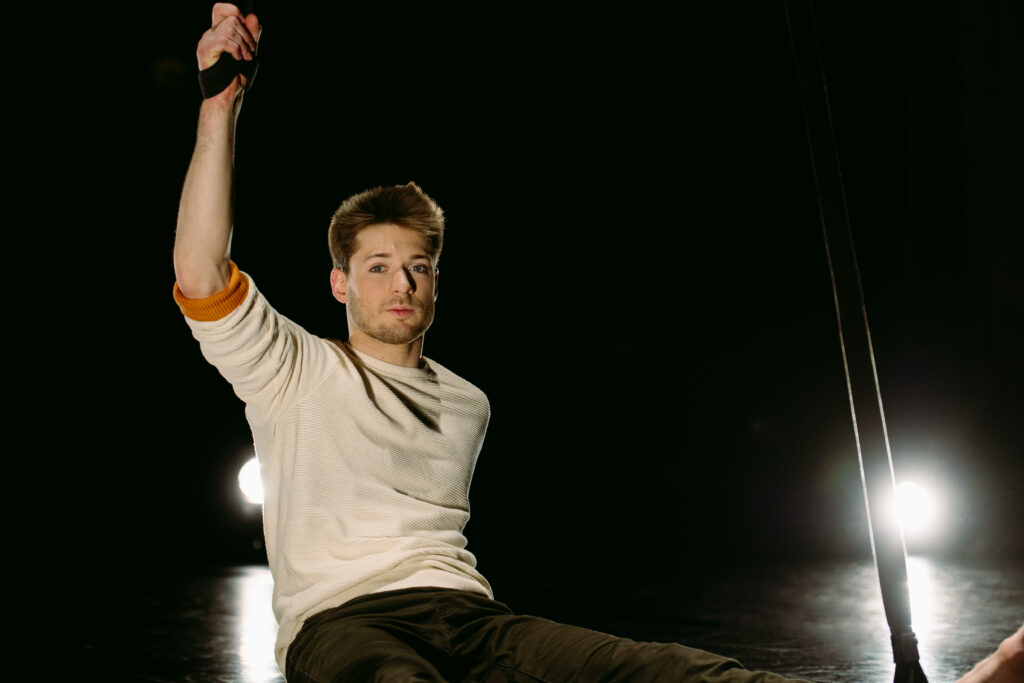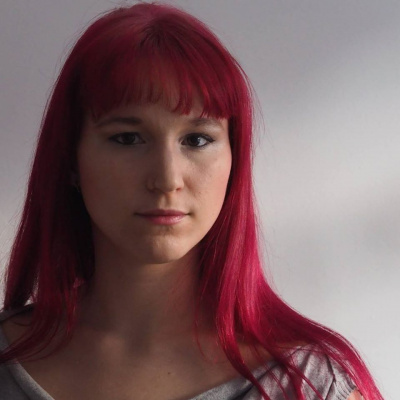“Asymmetrical Straps”: New Aerial Apparatus Developed by Marceau Bidal, Student of the National Circus School of Montreal
Marceau Bidal, a student from the National Circus School of Montréal, developed a new type of circus equipment, called asymmetrical straps, a derivative of aerial straps. The new apparatus is a concept using two straps installed onto a pulley system that allows for new skills beyond those of traditional aerial straps. Let’s discover the process behind the creation of this new equipment.
Attending a higher education program to become a circus artist is very demanding. In addition to mastering several circus disciplines and creating and participating in several circus shows, students at the National Circus School of Montréal take courses in many areas related to the circus profession such as health and safety, acting, career management, and more. At the end of the three-year program, students present an act from their main discipline during their final exam. In other words, students don’t have time to take a break, and yet one student decided to challenge himself further: he would create his final exam act on a new discipline.
 Marceau Bidal was doing acrobatic research in September 2021 in one of the school’s studios, where the ceiling is very low. He had his foot in one strap and his hand in the other, and while looking at himself in front of a mirror, he wondered what it would be like if he pulled down with his hand and his foot went up. Of course, this is impossible to do with conventional straps. This was a question that, without knowing it, would change the course of his circus career. The next day he went to explain his idea of putting a single strap on a carabiner to the riggers, but they told him it wasn’t possible due to the friction of the carabiner. However, the idea did not end there, and the riggers continued to look for a solution. The first idea was to keep two independent straps and put a rope to connect them through a pulley. Over the next year, the prototype underwent many modifications, including rope length adjustments, the addition of blockers, the use of different types of knots, and more, to arrive at the current version on which Marceau could develop his act.
Marceau Bidal was doing acrobatic research in September 2021 in one of the school’s studios, where the ceiling is very low. He had his foot in one strap and his hand in the other, and while looking at himself in front of a mirror, he wondered what it would be like if he pulled down with his hand and his foot went up. Of course, this is impossible to do with conventional straps. This was a question that, without knowing it, would change the course of his circus career. The next day he went to explain his idea of putting a single strap on a carabiner to the riggers, but they told him it wasn’t possible due to the friction of the carabiner. However, the idea did not end there, and the riggers continued to look for a solution. The first idea was to keep two independent straps and put a rope to connect them through a pulley. Over the next year, the prototype underwent many modifications, including rope length adjustments, the addition of blockers, the use of different types of knots, and more, to arrive at the current version on which Marceau could develop his act.
Most people may not realize what it means to create new circus equipment and a new act on that equipment. The process of designing and manufacturing new equipment is a long one. From the first idea to the final prototype, it can take several years depending on the complexity of the equipment. Furthermore, the work does not stop there, as it is necessary to develop a new acrobatic vocabulary. For the artist, they begin at square one as they have no idea how the equipment will behave. They have to experiment, try new movements, and understand how this equipment moves or works, and this whole process can also take months or years. Marceau said, “What was more complicated was to develop all the vocabulary, because, in the end, it’s such a new apparatus. There was nothing to rely on, I had to learn, so it means re-learning, re-adapting all the classical techniques of the straps.’’ For a circus school student, it’s much easier to create new skills on already-established circus equipment where the teachers know the basic acrobatic techniques.
A new piece of equipment can also have unknowns in terms of security. In Marceau’s case, the riggers made sure to build a safe piece of equipment, but challenges arose when using it. The grip was a challenge for Marceau, as the asymmetrical straps do not react like conventional ones, and he had to find the best attachment of the straps to his wrists in order to feel secure. Marceau documented his recommendations for the best grip, and these are available on the National Circus School website here.
Working as a research engineer in circus, I am fascinated by the innovation mechanisms of acrobatic equipment. I conducted a study based on 12 experts from leading companies in Quebec who were interviewed on their experiences in acrobatic equipment design. The study aimed to determine the factors that promote or limit the development of new apparatuses, as well as what helps the transition to a new discipline. The results of this study will be published next year. It is impressive, however, to see the parallels between Marceau’s story and what is emerging from the expert interviews. One aspect that was mentioned several times is the fact that for a new creation to become a discipline, it is necessary that the acrobat who developed it has the desire to diffuse, to make known, and to transmit his creation. “I would be happy if one day, there is a student who comes to school and wants to do asymmetrical straps; I think it would be a great success,” said Marceau.
Asymmetrical straps have not yet demonstrated their full potential and there is still much to explore. Whether in pairs or groups, on the ground or in the air, Marceau has embarked on a long adventure. I asked him for his three tips for anyone looking to develop new equipment. I found his answers interesting:
1) Don’t hesitate to push the idea and see how far it can go.
2) Surround yourself well.
3) Stay safe.

Marceau recognizes the opportunity to have been well-supported: “My teacher and my artistic advisor really followed. They embarked right away with the idea.“ In an environment where straps are currently extremely popular, Marceau chose to develop a new type of equipment to differentiate himself and to be unique. One can only admire the path he has taken.
Images feature Marceau Bidal. Images are courtesy of the artist and the author. Photo @Frédéric Langevin.
Do you have a story to share? Submit your news story, article or press release.






